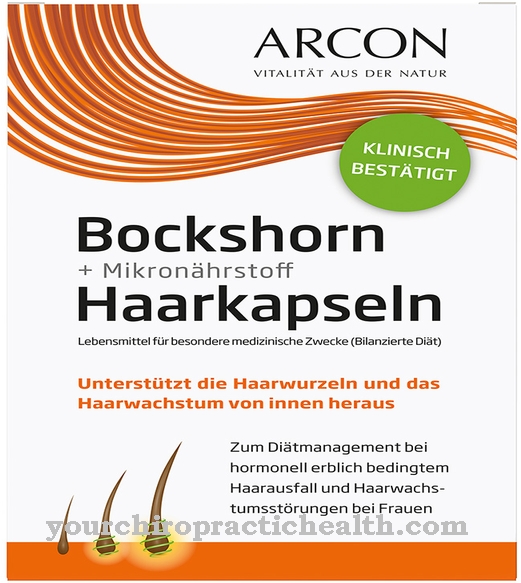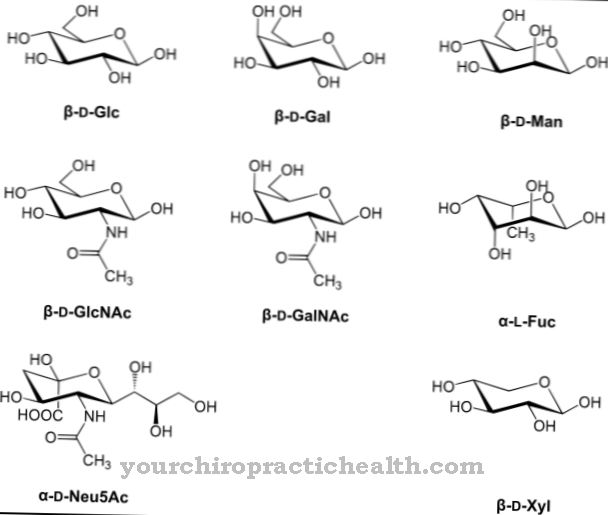Myosin belongs to the motor proteins and is responsible, among other things, for the processes involved in muscle contraction. There are different types of myosins, all of which participate in the transport processes of cell organelles or in shifts within the cytoskeleton. Structural deviations in the molecular structure of the myosin can under certain circumstances be the cause of muscle diseases.
What is myosin?
Along with dynein and kinesin, myosin is one of the motor proteins that are responsible for the processes of cell movement and transport processes within the cell. In contrast to the other two motor proteins, myosin only works with actin. Actin, in turn, is part of the cytoskeleton of the eukaryotic cell. It is therefore responsible for the structure and stability of the cell.
Furthermore, actin with myosin and two other structural proteins form the actual contractile structural unit of the muscle. Two thirds of the contractile proteins in muscle are myosins and one third are actin. However, myosins are not only present in muscle cells, but also in all other eukaryotic cells. This applies to unicellular eukaryotes as well as to plant and animal cells. The microfilaments (actin filaments) are involved in the structure of the cytoskeleton in all cells and, together with myosin, control the protoplasmic currents.
Anatomy & structure
Myosins can be divided into different classes and subclasses. There are currently over 18 different classes known, with classes I, II and V being the most important. The myosin found in the muscle fiber is called conventional myosin and belongs to class II. The structure of all myosins is similar. They all consist of a head part (myosin head), a neck part and a tail part.
The myosin filaments of the skeletal muscle consist of around 200 myosin II molecules, each with a molecular weight of 500 kDa. The headboard is genetically very conservative. The division into structural classes is mainly determined by the genetic variability of the tail part. The head part binds to the actin molecule, while the neck part acts as a hinge. The tail parts of several myosin molecules accumulate and form filaments (bundles). The myosin II molecule consists of two heavy and four light chains.
The two heavy chains form a so-called dimer. The longer of the two chains has an alpha-helix structure and is made up of 1300 amino acids. The shorter chain consists of 800 amino acids and represents the so-called motor domain. It forms the head part of the molecule, which is responsible for the movements and transport processes. The four light chains are connected to the head and neck of the heavy chains. The light chains further away from the head are referred to as regulatory and the light chains close to the head as essential chains. They are very affine to calcium and can thus control the mobility of the neck part.
Function & tasks
The most important function of all myosins is to transport cell organelles in eukaryotic cells and to carry out shifts within the cytoskeleton. The conventional myosin II molecules, together with actin and the proteins tropomyosin and troponin, are responsible for muscle contraction. To do this, myosin is first integrated into the Z-disks of the sacomer using the protein titin. Six titin filaments fix a myosin filament.
In the sacomer, a myosin filament forms around 100 cross-connections to the sides. Depending on the structure of the myosin molecules and the content of myoglobin, several forms of muscle fibers can be distinguished. Muscle contraction takes place within the sacomer due to the movement of the myosin in the cross-bridge cycle. First of all, the myosin head is firmly attached to the actin molecule. Then ATP is split into ADP, whereby the released energy leads to the tension of the myosin head. At the same time, the light chains ensure an increase in calcium ions. This causes the myosin head to attach itself to a neighboring actin molecule as a result of a conformational change.
By releasing the old connection, the tension is now converted into mechanical energy by a so-called force impact. The movement is similar to a stroke of the oar. The myosin head tilts from 90 degrees to between 40 and 50 degrees. The result is muscle movement. During muscle contraction, only the length of the sacomer is shortened, while the lengths of actin and myosin filaments remain the same. The ATP supply in the muscle is only sufficient for about three seconds. By breaking down glucose and fat, ADP is converted back to ATP so that chemical energy can still be converted into mechanical energy.
Diseases
Structural changes in myosin caused by mutations can lead to muscle diseases. An example of such a disease is familial hypertrophic cardiomyopathy. Familial hypertrophic cardiomyopathy is a hereditary disease that is inherited as an autosomal dominant trait. The disease is characterized by a thickening of the left ventricle without dilation.
With a prevalence of 0.2 percent in the general population, it is a relatively common heart disease. This disease is caused by mutations that lead to structural changes in betamyosin and alphatropomyosin. This is not one but several point mutations of the proteins involved in the structure of the sacomer. Most of the mutations are located on chromosome 14. Pathologically, the disease manifests itself as a thickening of the muscles in the left ventricle.
This asymmetry of the heart muscle thickness can lead to cardiovascular complaints with cardiac arrhythmias, shortness of breath, dizziness, loss of consciousness and angina pectoris. Although many patients have little or no impairment of their heart function, progressive heart failure may develop.









.jpg)



.jpg)



.jpg)







.jpg)


